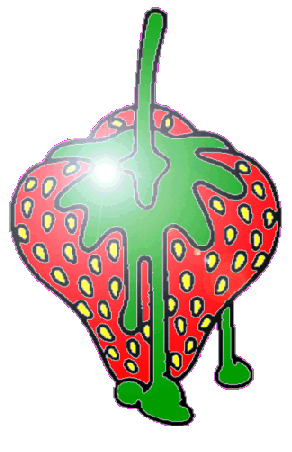
PART 1: FOLK CLUB DAYS
Part 1: Folk Club Days
Part 2: Electric Band
Part 3: After The Break
Part 4: Don't Say Goodbye
Part 5: End Of The Millenium
Part 6: Acoustic Odyssey
Part 7: Multiple Line-Ups
Part 8: 40 and Counting ...
Part 9: Hero arising and the big 50
Strawberry Hill forever
Dave Cousins and Tony Hooper met at school in West London, and, influenced at first by the late 50s skiffle boom - Lonnie Donegan was riding high in the charts with "Rock Island Line" - they put together a jug-band called the Gin Bottle Four. Next the pair switched to blues, folk and bluegrass music - getting into blues legend Leadbelly and traditional folk performers such as Ewan MacColl and Peggy Seeger. Flat-pick guitarist Rambling Jack Elliott, Woody Guthrie, and leading bluegrass exponent Bill Clifton, now resident in England, were also great influences. Dave went out and bought a banjo and became one of the fastest and best banjo players in the UK.
Dave spent three years studying statistics at Leicester University whilst Tony stayed in the metropolis to study electrical engineering at Brunel. Whenever Dave was back from college though, he would persuade Tony to get his guitar out of the attic and hit the folk clubs. On one of these occasions - thought to be at some point in late 1963 - Dave dragged Tony over to Strawberry Hill to meet a mandolin player called Arthur Phillips. They played together for a while and decided to form a band.
Their first performance was at a folk club in Clapham, run by Russell Quaye and his wife Hilda Syms in the back room of their house. On arrival, asked for the name of their band, Dave, improvising brilliantly, suggested that, as they rehearsed in Strawberry Hill in Twickenham, they should be known as the Strawberry Hill Boys.
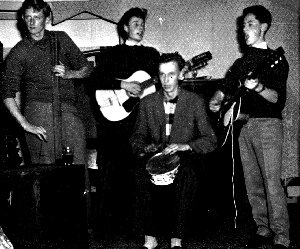 |
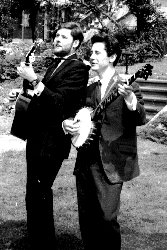 |
|
| The Gin Bottle Four | Early duo photo |
By 1964, they had a regular slot at a West London club, and were performing regularly around the London folk club circuit. However, Arthur Phillips decided to leave and Cousins and Hooper recruited Talking John Berry to take his place; Berry played double bass and was an exponent of the "talking blues". Around this time, the Boys also started performing close-harmony material, influenced by US band the Limeliters. Whilst keeping up his solo work, John Berry was with the Boys for a year or so. After he left, Dave and Tony carried on as a duo for a while, performing at the very first Cambridge Folk Festival in 1965.
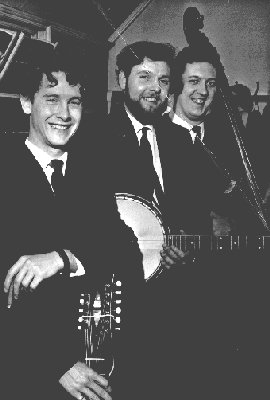
And now we are three ...
The UK folk boom was by now well under way, with new clubs opening every week, and the Boys, now often affectionately known as the Strawbs, were regular visitors to key London clubs like the Troubadour in Earls Court, Les Cousins in Greek Street, the Scots Hoose in Cambridge Circus and the Half Moon in Putney. They were also familiar voices on BBC radio, appearing on a variety of folk and bluegrass shows.
In 1966, Dave and Tony opened their very own club, the legendary White Bear in Hounslow, only a few hundred yards from Dave's home, at which many well known names appeared. With their own club guaranteeing them regular exposure, the duo began to include their own songs alongside the hillbilly music. Eventually the self-written material replaced the bluegrass and traditional folk material in their act.
Copenhagen bound
Whilst looking for acts for the White Bear, Tony had met double bass player Ron Chesterman in the Hampstead folk clubs. Ron - who also possessed his own transport - joined the band, which by June 1967 had formally been renamed the Strawbs. During the course of that summer, the trio hooked up with rising folk diva Sandy Denny, and very soon afterwards found themselves recording what they hoped would be their debut album in a recording studio in Copenhagen. Dave's song "Ringing Down The Years", written about Sandy after her tragic death in 1978, recalls first meeting Sandy at the Troubadour and being so impressed with her that he immediately asked her to join the Strawbs. Dave has recently recalled recording the first ever version of "Who Knows Where The Time Goes" in his front room at Hounslow round about this time.

Sandy Denny c. 1967
The Copenhagen connection came through a contact with Radio 1 DJ Tom Browne, who took some demo tapes recorded at Cecil Sharp House with Sandy (and her boyfriend - later her husband - Trevor Lucas knocking out a rhythm on the back of a guitar case) to Karl Knudsen, the head of Sonet Records in Denmark, who offered them a record deal. Browne also fixed the band up with a short term residency at the Vise Vers Hus in Tivoli, which paid for the trip.
The band appeared in the club at night, and spent the day in the studio, which was in fact the stage of a cinema. Between tea-time and around 10.00 the cinema was actually in use, so the recording equipment had to be tidied away at the end of each afternoon, and the band returned after their show to record into the early mornings. Using fairly basic 2-track equipment, the material was recorded pretty much live, though strings were overdubbed onto some of the tracks. The album would have featured the first recorded version of Sandy's haunting "Who Knows Where The Time Goes", later recorded by Fairport and Judy Collins.
The link with Sandy was fairly short-lived: her solo career was taking off, after her album with Alex Campbell and "friends", followed swiftly by her own well-received solo album. Dave Cousins was charged with finding a UK record label for the Copenhagen tapes, but by the time he had done so, Sandy had moved on (at first returning to solo gigs, but later joining Fairport Convention in May 1969).
Various record labels considered the Copenhagen tapes: Polydor was apparently interested enough to agree to release the album (despite the fact that the Strawbs no longer had a female singer - Curved Air vocalist Sonja Kristina had played a few gigs after Sandy's departure, but they quickly reverted to an all-male three-piece). However, Polydor wanted a single. So the trio went into the studio and recorded "Oh How She Changed" and "Or Am I Dreaming". But in the meantime, tapes sent by Karl Knudsen in Denmark to his contacts at Herb Alpert and Jerry Moss's new A&M label in Los Angeles led to the Strawbs becoming the label's first UK signing in April 1968.
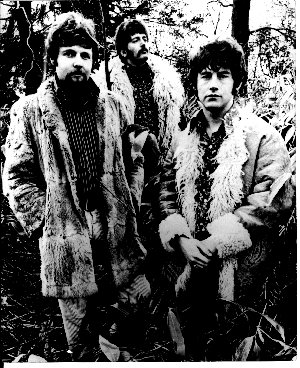
Publicity shots for the release of "Oh How She Changed" - the afghan coats and fancy shirts were reputedly manager John Gaydon's idea
The two tracks were released as their first single in June 1968. (The Copenhagen tapes were left in the vaults, and later issued as All Our Own Workby UK budget label Pickwick in 1973 after the success of "Part Of The Union". They were subsequently revised in 1991 for the Sandy and the Strawbs CD by Fairport producer Joe Boyd, who emphasised Sandy rather than the Strawbs.)
The first album
The single had been produced by Gus Dudgeon, who shared a house with Tony Hooper (along with most of the members of popular folk band the Settlers). Dudgeon, these days best known for producing many of Elton John's biggest hits, but then in the early stages of his career, brought in Tony Visconti as arranger. Using this team, the band set about recording their debut album, entitled simply Strawbs.
Their approach was ambitious and they recruited a wide variety of supporting musicians - Led Zeppelin's John Paul Jones on bass, Nicky Hopkins on piano, Alan Parker on lead guitar. Some tracks featured a reconstructed Ted Heath Band which provided "big band" backing, others utilised a 36-piece orchestra to provide lush strings. On one track "Tell Me What You See In Me", they dragged in an Arab band from a London restaurant, immortalised in the sleeve notes as "Nosrati and his Arab friends" to provide an Eastern backing. The Arabs spoke no English and all negotiations were carried on in halting French, the only common language. Some of the material was reworked from the Sandy Denny tapes with both Cousins and Hooper taking on lead vocals. The whole thing was bound together with instrumental links and spoken word passages.
They played the finished product to A&M executives, who were horrified - they thought they had signed a psychedelic band, but found they had a trio of heavily orchestrated pop hopefuls. Cousins and co. were asked to return to the studio to replace some of the more pop-oriented material with more appropriate folk-based material, which they did. The second sessions also produced Cousins' epic "The Battle", a sign of things to come.
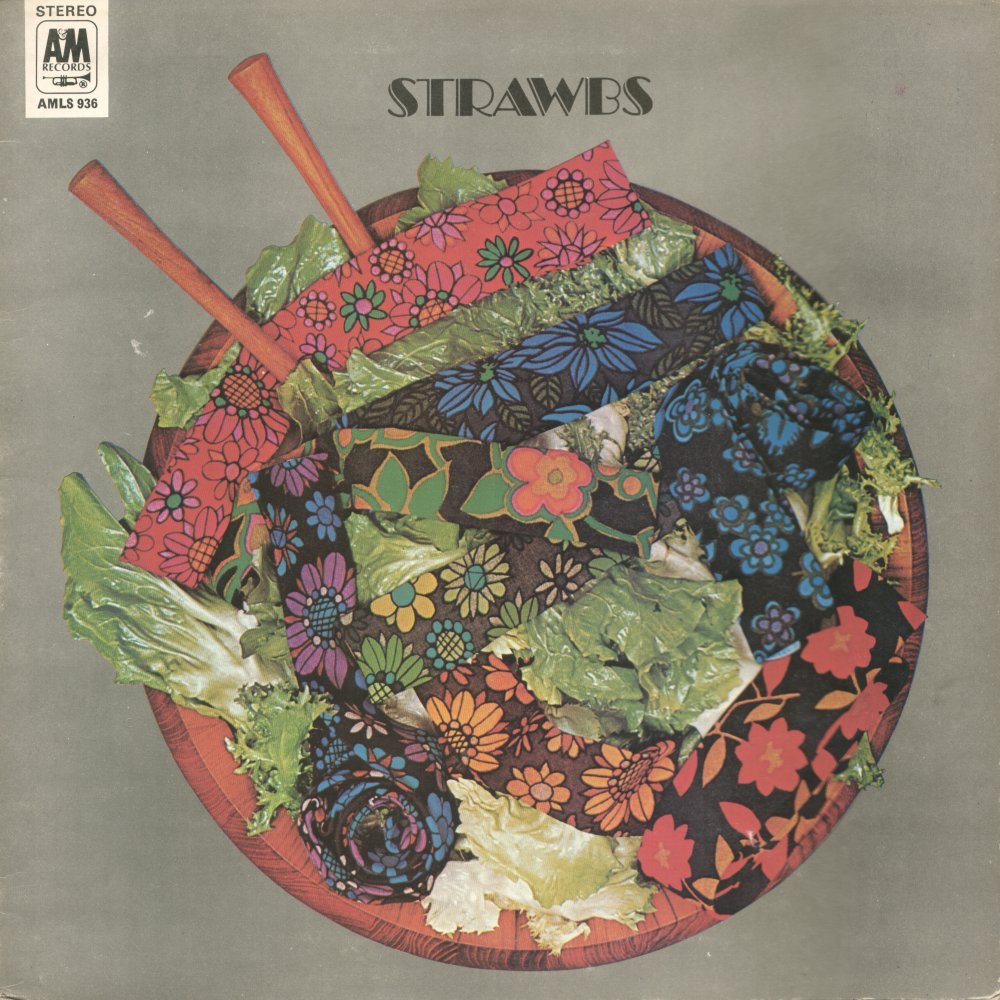

The first album ... and the Sampler
(The outtakes later surfaced on a privately pressed album - less than 100 copies printed so as to avoid UK "Super" tax - The Strawberry Music Sampler No. 1, which was distributed to music publishers and agents in order to encourage other artists to cover their songs.) In the meantime, Simon & Garfunkel issued their "Bookends" album, which also employed linking passages. Cousins and Hooper reluctantly dropped their links from the final version of the album, apart from the introduction to "The Man Who Called Himself Jesus" (their second single, released in November 1968 to bridge the gap whilst the album was revised, and banned by the BBC for its controversial religious content). That link was spoken by actor Richard Wilson, now better known for his role as Victor Meldrew in BBC's "One Foot In The Grave". In the end, the revised first album came out in June 1969, and was well received by critics and fans. The only complaint was that, with all the guest artists involved, the band as they stood - an acoustic trio - were unable to reproduce the same sound on stage.
Dragonfly
The cost of the first album had been astronomical for the time - particularly as they had to go back and record extra tracks - so the advance from A&M had been pretty well extinguished. Their next album, Dragonfly had therefore to be recorded on a very tight budget indeed. The relationship with Gus Dudgeon had been difficult - Cousins and Dudgeon had argued about mixing levels throughout - and Cousins initially had discussions with Joe Boyd about producing the next album. Though this never came off, Cousins had been talking about adding an extra instrument and Boyd suggested cellist Clare Deniz, with whom he had worked on Nick Drake's first album. Deniz joined the Strawbs in August 1969, and shortly afterwards, the band were on the ferry to Denmark, to record once again in Ivar Rosenberg's studios in Copenhagen.
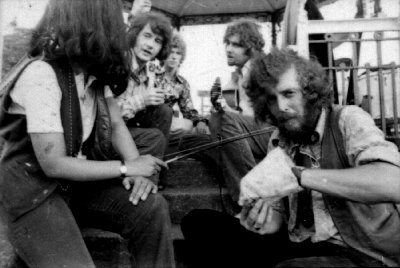
Deniz, Hooper, Cousins and Chesterman at an outdoor acoustic gig, with David Bowie looking on
Dragonfly's producer was Tony Visconti, whose arrangements on the first album had impressed the band. He encouraged Dave to develop the classical feeling in his songs and helped the Strawbs make a pretty, acoustically based, album, and one which actually sounded like the Strawbs as they were then configured. Armed with a theory of music textbook, Cousins transcribed the cello parts for Clare Deniz (twice, as his first attempt had all been written in the treble clef). The Strawbs had already chosen the songs for the album and provided basic arrangements for two guitars, bass and drums (provided by local drummer Bjarne Rostvold), though Visconti was to suggest a final closing track "Close Your Eyes" - an engaging lullaby - to mitigate the possible "bad trip" effect of Cousins powerful epic "Vision Of The Lady Of The Lake " which formed the album's centrepiece, following in the footsteps of the first album's "The Battle".
The basic tracks for the album were laid down in Copenhagen, and Rick Wakeman and Paul Brett added overdubs to "Vision" at the newly opened Morgan Studios in the UK, though there were problems: the tracks recorded in Denmark were out of tune with the piano in the UK studio and there was no varispeed machine, so Wakeman had to play the piano through a Leslie speaker to make it distorted so the fact that it was out of tune was disguised. Other tracks recorded for the album displayed the same inventiveness, making the best out of a very tight budget. The title track "Dragonfly" was the first song written on Dave's newly acquired dulcimer.
"Josephine, For Better Or For Worse" was rescued from the outtakes of the first album, and is here given an attractive acoustic backing rather than the breathy nightclub ambience, intended as a tribute to label owner Herb Alpert. "Josephine" was a song dating back to Strawbs' drinking days in the London folk clubs, when they found a willing companion in Brendan Behan's brother Dominic.
A single, "Forever", the basic tracks of which were recorded in Copenhagen, but which was subsequently heavily overdubbed, was released (with "Another Day" on the B-side) at the same time as the QEH concert with the five-piece band in July 1970 - a fairly odd decision by A&M.
By the time that Dragonfly was released, however, Clare had realised, that as a non-smoking, non-drinking vegetarian, her lifestyle didn't mix well with the Strawbs, and had returned to her classical music career, leaving the Strawbs once again to promote an album which, without a cellist, didn't reflect their current line-up. They recruited, briefly, jazz musician Lindsay Cooper to play cello, but when Ron Chesterman also left the band to join Noel Murphy and Shaggis (aka Davey Johnstone, later Elton John's lead guitarist), Cooper switched to bass.
At that point, Cousins recruited Rick Wakeman on keyboards - a change that was to have a profound effect on the development of the Strawbs .....
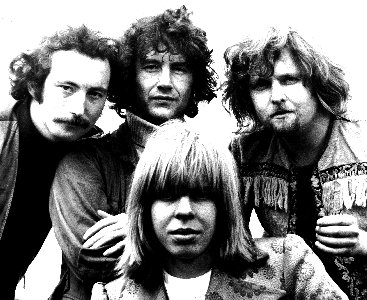
Cooper, Hooper and Cousins with new recruit Rick Wakeman in front

